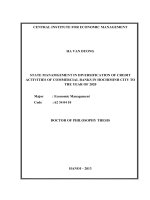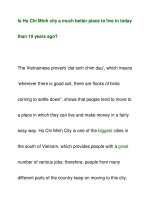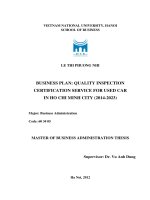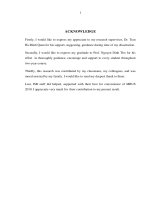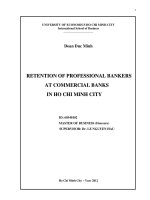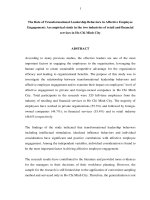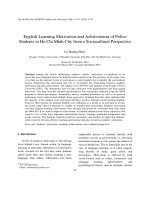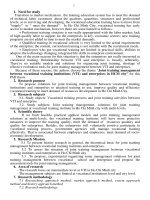Factor effecting guests satisfaction toward luxury hotel in ho chi minh city a mediation analysis of perceived service quality
Bạn đang xem bản rút gọn của tài liệu. Xem và tải ngay bản đầy đủ của tài liệu tại đây (1.2 MB, 133 trang )
VIETNAM NATIONAL UNIVERSITY – HO CHI MINH CITY
INTERNATIONAL UNIVERSITY SCHOOL OF BUSINESS
FACTOR EFFECTING GUESTS’ SATISFACTION TOWARD LUXURY
HOTEL IN HO CHI MINH CITY – A MEDIATION ANALYSIS OF
PERCEIVED SERVICE QUALITY
In Partial Fulfillment of the Requirements of the Degree of
MASTER OF BUSINESS ADMINISTRATION
In International Business Major
By
Ms. Ngo Hoai Diem Nga
ID: MBA05022
International University - Vietnam National University HCM
Jan 2014
1
FACTOR EFFECTING GUESTS’ SATISFACTION TOWARD LUXURY
HOTEL IN HO CHI MINH CITY – A MEDIATION ANALYSIS OF
PERCEIVED SERVICE QUALITY
In Partial Fulfillment of the Requirements of the Degree of
MASTER OF BUSINESS ADMINISTRATION
In International Business Major
By
Ms. Ngo Hoai Diem Nga
ID: MBA05022
Business School, International University,
Vietnam National University, HCMC Jan 2014
Under the guidance and approval of the committee, and approved by all its
members, this thesis has been accepted in partial fulfillment of the requirements
for the degree.
Approved:
---------------------------------------------- --------------------------------------Advisor: Dr. Mai Ngoc Khuong
Chairperson
---------------------------------------------- --------------------------------------Committee member
Committee member
---------------------------------------------- --------------------------------------Committee member
Committee member
2
ACKNOWLEDGEMENT
I would like to express my thanks to all those who gave me the opportunity to
complete this dissertation. I am honored to give my deepest gratitude to Dr. Mai Ngoc
Khuong, who offered me valuable ideas and suggestions throughout the process of the
research.
I also owe my thankfulness to these close friends. They not only assisted me in
conducting the survey but also shared their networks by contacting the managers of the
hotels where I collected the data.
I would also like to acknowledge the encouragement I received from all of them.
Most importantly, my special appreciation goes to my parents for their
thoughtfulness and encouragement all the way from the very beginning of my education.
i
LIST OF ABBREVIATIONS
Abbreviations
Equivalence
TAN
Tangible
EMP
Empathy
REL
Reliability
IMAGE
Hotel image
PRICE
Price
PERSEQUA
Perceived service quality
GUESATIS
Guest satisfaction
IDV (s)
Independent variables
DV(s)
Dependent variables
ii
PLAGIARISM STATEMENT
I would like to declare that, apart from the acknowledged references, this thesis
either does not use language, ideas, or other original material from anyone; or has not
been previously submitted to any other educational and research programs or institutions.
I fully understand that any writings in this thesis contradicted to the above statement will
automatically lead to the rejection from the MBA program at the International University
– Vietnam National University Ho Chi Minh City.
iii
COPYRIGHT STATEMENT
This copy of the thesis has been supplied on condition that anyone who consults it
is understood to recognize that its copyright rests with its author and that no quotation
from the thesis and no information derived from it may be published without the author’s
prior consent.
© Ngo Hoai Diem Nga / MBA05022 / 2012 -2014
iv
Table of Contents
ACKNOWLEDGEMENT ................................................................................................... i
LIST OF ABBREVIATIONS ............................................................................................. ii
COPYRIGHT STATEMENT ............................................................................................ iv
List of Tables .......................................................................................................................x
List of Figures .................................................................................................................... xi
CHAPTER I – INTRODUCTION .......................................................................................1
1.1 Background of the study.............................................................................................. 1
1.2. The problem statement ................................................................................................ 5
1.3. Research question ........................................................................................................ 6
1.4. Research objectives ..................................................................................................... 7
1.5 Limitation and scope of the study ............................................................................... 8
1.6 Structure of the study .................................................................................................. 8
1.7 Chapter summary ...................................................................................................... 10
CHAPTER II - LITERATURE REVIEW .........................................................................11
2.1 Concepts .................................................................................................................... 12
a.
Tangible ................................................................................................................... 13
v
b.
Responsibility .......................................................................................................... 13
c.
Empathy ................................................................................................................... 13
d.
Assurance ................................................................................................................. 13
e.
Reliability................................................................................................................. 14
f.
Price ......................................................................................................................... 14
g.
Hotel image .............................................................................................................. 15
h.
Service quality ......................................................................................................... 16
i.
Perceived service quality ......................................................................................... 16
j.
Perceived value ........................................................................................................ 19
k.
Customer satisfaction ............................................................................................... 21
l.
The European Customer Satisfaction Index (ECSI) model ..................................... 23
m.
Relationship among Hotel Image, Service Quality, Perceived Value, and Customer
Satisfaction ........................................................................................................................ 25
2.2. Conceptual framework .............................................................................................. 25
2.3. Research hypothesis .................................................................................................. 26
2.4 Chapter summary ...................................................................................................... 28
CHAPTER III - RESEACRH METHODOLOGY ............................................................30
vi
3.1 Target population, population sample size ................................................................ 30
3.2 Research instrument .................................................................................................. 30
3.3 Data collection ........................................................................................................... 34
3.4 Data analysis.............................................................................................................. 35
3.5 Reliability test............................................................................................................ 39
3.6 Validity test ............................................................................................................... 40
3.7 Chapter summary .................................................................................................... 50
CHAPTER IV - RESEARCH FINDING ............................................................................51
4.1 Introduction ............................................................................................................... 51
4.2 Characteristic of sample ............................................................................................ 51
4.2.1 Demographic characteristic of the sample ............................................................... 51
4.2.2 Descriptive statistic of variable ................................................................................ 54
4.3 Hypothesis testing ....................................................................................................... 56
4.3.1 Multiple regression .................................................................................................. 56
4.3.2 Factor affect to perceive service quality .................................................................. 58
4.3.3 Factor affect to guest satisfaction ............................................................................ 62
vii
4.3.4 Effect of perceived service quality to guest satisfaction .......................................... 65
4.3.5 Direct and indirect effects on guest satisfaction ...................................................... 67
4.3.7 Summary of path analysis ....................................................................................... 72
4.4 Chapter summary ........................................................................................................ 73
CHAPTER V - CONCLUSION AND FINDING .............................................................74
5.1 Summary and discussion of the finding .................................................................... 74
5.1.1 Relationships between IDVs and the guest satisfaction .......................................... 74
5.1.2 Direct effect on guest satisfaction ............................................................................ 77
5.1.3 Indirect effect on guest satisfaction ......................................................................... 78
5.2 Implication of the study ............................................................................................. 79
5.3 Chapter summary ...................................................................................................... 84
REFERENCE .....................................................................................................................85
Appendix 1: English Questionnaire .................................................................................. xii
Appendix 2: Vietnamese questionnaire .......................................................................... xvii
Appendix 3: Factor effect perceived service quality ..................................................... xxiii
Appendix 4: Factor affect to Guest satisfaction ............................................................. xxix
Appendix 5: Factor perceived service quality affect to guest satisfaction ................... xxxvi
viii
ix
List of Tables
Table 1: International tourist arrived in 2012 ....................................................................03
Table 2: Interpreting strength of Pearson correlation ........................................................37
Table 3: Interpreting strength of path coefficiemts............................................................38
Table 4: Cronbach alpha of independent variables (IDVs) ...............................................39
Table 5: Cronbach alpha of dependent variables (DVs) ....................................................39
Table 6: KMO and Bartlet ‘s Test for IDVs ......................................................................40
Table 7: KMO and Bartlet ‘s Test for DVs........................................................................41
Table 8: Factor statistics of IDVs ......................................................................................43
Table 9: Factor statistics of DVs ........................................................................................47
Table 10: Demographic Characteristic of the Sample (n = 277) .......................................52
Table 11: Descriptive statistic of IDVs ..............................................................................55
Table 12: Descriptive statistics of DVs .............................................................................55
Table 13: Pearson correlation between independent variables (IDVs) ..............................57
Table 14: Pearson correlation between independent variables (IDVs) and perceived
service
quality (PERSEQUA) ......................................................................................59
Table 15: Coefficients between IVs and PERSEQUA ......................................................61
Table 16: Pearson correlation between independent variables and guest satisfaction.......63
Table 17: Coefficients between IVs and GUESSATIS .....................................................64
Table 18: Pearson correlation between perceived service quality and guest .....................66
Table 19: Coefficients between PERSEQUA and GUESSATIS ......................................67
Table 20: Direct, Indirect, and Total Causal Effects .........................................................67
x
List of Figures
Figure 1: ECSI Model ........................................................................................................26
Figure 2: A Proposal Model of Guest Satisfaction ............................................................28
Figure 3: Adjusted conceptual model ................................................................................50
Figure 4: Path diagram of the Direct and Indirect effects on GUESATIS .......................69
xi
CHAPTER I – INTRODUCTION
1.1
Background of the study
Nowadays, the revenue from hospitality industry account a big part of the world
economy every year. Especially, in the developing countries the hotel service quality is
fast growing and it plays an important role in economics. Vietnam’ economics is
increasing rapidly, the trend of the industry in the country has gradually been transformed
from agriculture to manufacturing and service industry. In Vietnam, within 10 years,
GDP from Tourism increase over 20% every year. Tourism is one five sector, that have
highest oversea income, and count over 55% export service. Service’s labor force counts
31% of Vietnamese population (Tourism Bureau).
According to the General Statistics Office (GSO), the number of international
arrivals to Viet Nam in July 2013 was estimated 658,325, increasing by 16% in
comparison with June 2013 and 28.5% over the same period of 2012. In July,
international arrivals to Viet Nam by air reached 506,388, an increase of 24.3% over July
2012; by sea: 18,947 (down 27.1%); by road: 132,990 (up 68.3%). (See the Table 1)
With this growth, the total number of international arrivals to Viet Nam in 7
months was 4,198,728, up 5.9% over the same period of 2012, fulfilling 58.3% of the
goal in 2013.
Viet Nam tourism sector has set the target of receiving 7.2 million international
arrivals in 2013. Moreover, according to the annual survey of the purchasing intention of
inbound and outbound tourist, international tourist stay in 3 stars hotels decrease 1.6%
1
but 5 stars hotels increase from 5% to 5.3%. Besides, the percentage of domestic tourist
stay in luxury hotel suddenly raise up 3.6%.With high requirement, many local and
international hotels increase steadily so the improvement in service quality is necessary.
Realizing the increase in competition among hotels, hotel managers are focusing on
improving service quality to put them in a competitive advantage (Min&Min, 1996). In
this intense competitive market, it is essential for local and international hotels to inquire
about good values and tool for improving service quality (Narangajavana and Hu, 2008).
The competition in global market among hotels is very powerful (Chen, 2008). Any hotel
cannot survive in this competitive environment, until it satisfies its customers with good
quality service (Narangajavana and Hu, 2008). Customer satisfaction has been viewed as
an important issue because of its impact on customer retention and positive word of
mouth reputation. The most important five dimensions in tourist guest satisfaction is
accommodation, beauty spots, cuisine, transportation .Therefore, the Vietnamese
government and hoteliers have reached a consequence to raise the quality of lodging
service and encourage the hotel industry to improve hotel service quality so as to enable
the hospitality industry to reach international standards. However, no customer
satisfaction data are available for the hotel industry specifically. And each hotel has its
own criteria to evaluate le the level of customer satisfaction. There is no common
accepted and officially standard to measure customer satisfaction through hotel.
Therefore, the purpose of study was to evaluate the effect of guest satisfaction through
hotel service quality, and develop the guest satisfaction model to improve hotel service
quality in Saigon luxury hotel system.
2
Table 1: International tourist arrived in 2012
Compare 12
Estimate
12 month in
12/2012
2012
Compare
Compare
months in
12/2012 to last 12/2012 to
2012 to 12
month (%)
12/2011
months in
2011
Total
614.673
6.847.678
93,74
103,58
113,86
Means of transportation
Airways
516.673
5.575.904
92,25
104,61
110,82
Seaways
15.000
285.546
110,91
176,47
616,45
Road
83.000
986.228
101,10
91,21
105,35
Purpose of vacation
Travelling,
relaxing
Business
Family
visiting
Others
373.396
4.170.872
93,5
103,64
114,23
107.527
1.165.966
92,80
108,65
116,25
102.568
1.150.934
94,13
103,20
114,26
31.182
359.906
98,99
89,66
102,11
Market segment
Russia
13.648
174.287
58,56
136,10
171,49
Finland
1.592
16.204
193,91
142,25
142,87
Korea
64.978
700.917
108,71
122,77
130,67
Malaysia
35.058
299.041
112,91
152,40
128,27
Laos
13.554
150.678
88,33
115,93
127,16
Thailand
21.639
225.866
85,20
120,62
124,22
Japan
51.890
576.386
97,65
109,22
119,70
Sweden
3.619
35.735
133,59
122,43
119,29
Philippines
7.790
99.192
81,54
90,97
114,29
22.513
196.225
115,18
132,3
113,78
Singapore
3
Compare 12
Estimate
12 month in
12/2012
2012
Compare
Compare
months in
12/2012 to last 12/2012 to
2012 to 12
month (%)
12/2011
months in
2011
28.564
409.385
92,62
80,18
113,39
Swiss
2.342
28.740
82,15
92,95
112,54
Italy
2.361
31.337
79,41
84,40
110,54
Indonesia
5.443
60.857
98,82
99,60
109,88
England
13.685
170.346
75,80
88,74
108,99
Denmark
1.826
27.970
84,93
71,92
108,69
Canada
9.043
113.563
90,33
86,12
106,72
France
16.814
219.721
76,99
80,59
103,91
Norway
1.734
19.928
114,61
90,00
102,06
Holland
3.803
45.862
88,57
85,60
101,86
America
36.480
443.826
99,47
84.05
100,90
China
141.117
1.428.693
88,11
100,94
100,84
New Zealand
2.337
26.621
95,86
89,33
100,41
Australia
28.216
289.844
116,48
98,69
100,06
Spain
2.125
31.305
65,14
66,32
96,40
Germany
9.155
106.608
75,98
81,43
93,57
Delgium
1.706
18.914
287,69
79,08
86,50
Hongkong
700
13.383
46,85
43,64
82,33
Cambodia
32.589
331.939
98,93
78,00
78,39
Others
38.352
554.307
93,11
158,79
226,43
(Source: Vietnam National Administration of Tourism)
4
1.2.
The problem statement
Many authors like: Johnson, Gustafsson, Andreassen, Lervik, and Cha (2001)
demonstrated that many national and international customer satisfaction indices are
introduced a composition of cause and effect relationships or satisfaction models;
moreover, customer satisfaction indices could be developed and modified through the
models and methods used to measure customer satisfaction. Most indices are developed
in terms of the degree to which a product/service provides key customer requirement
(customization) and how reliably these requirements are delivered (Johnson, Gustafsson,
et al., 2001). There is no commonly accepted and official standard to measure customer
satisfaction across hotels in Vietnam. Hence, the hotel industry in Vietnam is in need of
an effective customer satisfaction model to improve the hotel service quality. After
reviewing the customer satisfaction indices in the literature, the researcher considered
that although international tourist hotels in Ho Chi Minh City ask guests to rate their
service quality and customer satisfaction though questionnaires, it is difficult to
determine what types of indices provide the most useful information for international
tourist hotels in Ho Chi Minh City. What index provides the competitive advantages for
Vietnamese international tourist hotels based on statistical findings?
The proposed consumer satisfaction model, which is based on customer opinions,
may vary from that of other countries due to the diversity of international tourists to Ho
Chi Minh City. To determine the validity and reliability of an index for Vietnamese
international tourist hotels, an appropriate customer satisfaction model and methods were
proposed and tested. A number of modifications to the customer satisfaction model were
made to fit the model to the Vietnamese international tourist hotel context.
5
Although Vietnam has many hotels, but there is no commonly accepted and
official standard to measure customer satisfaction in hotels. Customer satisfaction has
been viewed as an important issue for the hotel industry because of its impact on repeat
business and word-of-mouth reputation. In reality, the hotel industry in Vietnam has not
always responded satisfactorily to the customers’ demands for improvement. In Vietnam,
each hotel has its own criteria to evaluate the level of customer satisfaction. There is no
common accepted and official standard to measure customer satisfaction across hotels in
Vietnam. Hence, the hotel industry in Vietnam is in need of an effective customer
satisfaction model. If hotels objectively measure customer satisfaction using the common
model, they can improve the items which guests care about, as well as optimize resource
distribution for the hotel industry. So it is necessary to design a guest satisfaction that
suitable for Vietnamese hotel sector.
From the above reasons, I decided to choose the topic for my thesis as
follows:
“FACTOR EFFECTING GUESTS’ SATISFACTION TOWARD LUXURY
HOTEL IN HO CHI MINH CITY – A MEDIATION ANALYSIS OF
PERCEIVED SERVICE QUALITY ”
1.3.
Research question
From problem statement, the study raises the following research question:
“TO WHAT EXTENT ARE GUEST SATISFIED STAYING IN LUXURY
HOTELS IN HO CHI MINH CITY?”
6
1.4.
Research objectives
General objective
Generally, this research is to evaluate the guest satisfaction through the effect of
hotel service quality to propose a model for hotels in Ho Chi Minh City. The customer
satisfaction model proposed by the researcher for this study has seven dimensions:
tangible, reliability, empathy, hotel image, price, perceive quality and customer
satisfaction.
The specific objectives of the study were:
-
To achieve an overall understanding of hotel business
-
Develop a conceptual model of guest satisfaction for the hotel industry in Ho Chi
Minh in terms of the European Customer Satisfaction model and Parasuraman
model.
-
To determine which factors directly affect guests’ satisfaction
-
Test and analyze the relationships among tangible, empathy, reliability, hotel
image, price, perceived service quality
-
To measure the direct and indirect effects of the independent variables of
tangibility, reliability, empathy, price, and hotel image on the dependent variable
7
of guests’ satisfaction through the mediating variables of perceived service
quality.
-
Base on empirical results of this study, improvement and development
recommendation will be provided for hotel managers.
1.5
Limitation and scope of the study
-
The sample for the study cannot be generalized to the Vietnamese hotel industry
as a whole since it was not randomly selected sample. A convenience sampling
will be used in this study to collect data.
-
Geography limitation, samples are within the limit of hotel guests who stayed in
Ho Chi Minh City only.
-
Model development based on a literature review. So, in practical model may be
more complicated than theory. The operations of the hotel sector in the real world
include others variables such as: managers, employees, environmental
issues….which are not including in this study.
-
Within short time so the result may be not so good to generalized as a whole
population.
1.6
Structure of the study
This study includes 5 chapters. Chapter one comprised a few issues of the study
such as back ground of the study. This chapter also mentions the reason why I choose this
research. The objectives, main question and hypotheses, which are the framework for
8
researcher to follow up, were identified. Moreover, the limitation and scope are added to
modify the advantage and disadvantage the researcher have to face.
Chapter two included the literature review in the field of guest satisfaction. This
chapter showed the definitions of key concepts of hotel industry, satisfaction and
conceptual model of guest satisfaction. After that, the determinants of guest satisfaction
were clarified. Finally, the conceptual framework was built to evaluate the guest
satisfaction on hotel service quality.
Chapter three presented the method that this quantitative approach research was
conducted. Questionnaire design, target population, sample size, data collecting process
and data analysis techniques are clearly identified.
Chapter four presented the procedure how to come up with the result of data
analysis. From the raw data were input and analyzed by the statistical techniques such as
descriptive analysis, reliability, exploratory factor analysis, correlation, multiple
regression and path analysis, to the data findings.
Chapter five presented the discussion and recommendations based on the findings
in the previous chapter, focusing on factors that make guest satisfied with hotel service
quality. These recommendations are directed to tourist managers and on the other hand to
people working in the overall hotel industry.
9
1.7
Chapter summary
Chapter one was a chapter that generalize the overview of dissertation. It began
with background related to the study and then the induction about tourism industry in
Vietnam in recent years. Especially, the potential market was open and Vietnam tried to
develop the hospitality industry rapidly. This chapter also defined clearly the objective of
the study that was to identify the direct and indirect effect on guest satisfaction and
measure the hotel service quality through intervening variables (perceived service
quality).
Finally, it provided the practical improvement and development
recommendation to help the hotel managers had deeply knowledge of hotel industry.
10
CHAPTER II - LITERATURE REVIEW
This chapter included a review of the literature on 7 components of the customer
satisfaction index model proposed for this study including tangible, reliability, empathy,
price, hotel image, perceived service quality, and customer satisfaction. The literature is
reviewed to understand background information related to this study as well as to develop
a conceptual model for a customer satisfaction index for hotels in Vietnam. In addition,
the literature revealed that language ability in the hotel industry is an important issue
related to customer satisfaction.
Viewing customer satisfaction as a form of consumer purchasing behavior is
consistent with a framework for understanding customers’ wants and needs. The
framework of customer satisfaction includes important components that must be
described as a basis for the study reported herein. LeBlanc and Nguyen (1996) indicated
that five attributes including physical environment, contact personnel, quality of service,
corporate identity, and accessibility determine hotel image. Kandampully and Suhartnto
(2000) revealed that hotel image provides an important attribute for consumer loyalty.
Parasuraman, Zeithaml, and Berry (1988) indicated that service quality is the difference
between consumer expectations of service and perceived service. Rust, Zahorik, and
Keiningham (1995) presented that customer satisfaction indices offer possibilities to
value the profitability of various quality efforts. Therefore, the potential relationship
between service quality and customer satisfaction may be expected.
The perceived value is related to the price paid. The basic prediction is that when
service providers increase their price to improve on service quality, they expect that
11
consumer satisfaction will increase at the same time. Oliver (1980) demonstrated that
these expectations are argued to positively affect customer satisfaction because they serve
in the evaluation process.
The measurement of customer satisfaction may be an important predictor of
consumer purchasing behavior, customer retention and positive word of mouth
(Reichheld and Sasser, 1990).
2.1
Concepts
The SERVQUAL model offers a suitable conceptual frame for the research and
service quality measurement in the service sector. The model has been developed, tested
and adapted during various researches. The model is based on the definition of quality as
a comparison of the expected and the obtained as well as a consideration of gaps in the
process of service provision. SERVQUAL is based on the client’s evaluation of service
quality. The described concept is based on the gap between expectations and perception
of the clients. Service quality represents a multidimensional construction. The choice of
the most important characteristics was an issue dealt with in various ways. One of these is
a logical attempt to work out a list of desirable attributes from the basic needs of the
clients. A variant of a scale containing desirable characteristics of services, known as
SERVQUAL scale, is currently quite popular in literature. It was developed in marketing
circles with the aim to measure service quality (Baković, Lazibat). In the original
SERVQUAL instrument, Parasuraman et al. (1985) define service quality through ten
dimensions which they sum up in five in 1988:
12
